Connecting a pumping station to a well: rules for organizing autonomous water supply
Well drilling is completed, what next? It is necessary to organize a water supply that allows you to wash dishes, take a shower, water plants and connect household appliances. Connecting a pumping station to a well will help solve the problem. However, for a positive result, you need to know exactly how to do this.
We will tell you how to better organize automated water supply for a country house or favorite summer cottage using surface pumping technology. The article we presented describes in detail the technological rules and principles of circuit assembly. Taking into account our advice, you can easily set up the system with your own hands.
The content of the article:
Features of the pumping station design
Autonomous water supply based on a pumping station includes a set of devices that ensure automatic flow of water into the house. To organize a comfortable autonomous water supply, you need to select a suitable pumping unit, connect it correctly and configure it.
If the installation is done correctly and the operating instructions are followed, it will last a very long time. The house will always have clean water under pressure, allowing you to use modern appliances: from a regular shower and washing machine to a dishwasher and a jacuzzi.
The pumping station consists of three main elements:
- a pump that supplies water;
- hydraulic accumulator, where water is stored under pressure;
- control block.
The pump pumps water into hydraulic accumulator (GA), which is a reservoir with an internal insert of elastic material, often called a membrane or bulb due to its shape.
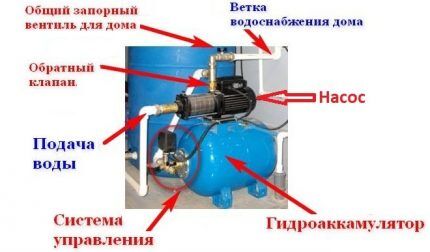
The more water in the accumulator, the stronger the resistance of the membrane, the higher the pressure inside the tank. When liquid flows from the HA into the water supply, the pressure decreases. The pressure switch detects these changes and then turns the pump on or off.
It works like this:
- Water fills the hydraulic tank.
- The pressure rises to the upper set limit.
- Pressure switch turns off the pump, the flow of water stops.
- When the water is turned on, it begins to flow out of the HA.
- The pressure decreases to the lower limit.
- The pressure switch turns on the pump, the tank is filled with water.
If you remove the relay and hydraulic accumulator from the circuit, the pump will need to be turned on and off every time the water is opened and closed, i.e. Often. As a result, even a very good pump will quickly break down.
Usage hydraulic accumulator provides owners with additional bonuses. Water is supplied to the system under a certain constant pressure.
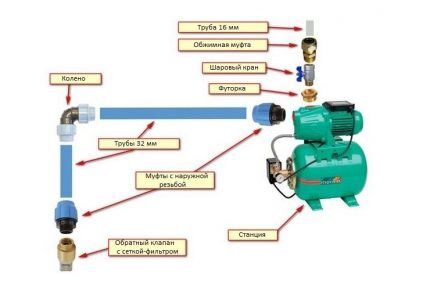
Good pressure is needed not only to take a shower comfortably, but also to operate an automatic washing machine or dishwasher, hydromassage and other benefits of civilization.
In addition, a small (about 20 liters) but necessary supply of water is stored in the tank if the equipment stops working. Sometimes this volume is enough to last until the problem is resolved.
Installation location: convenient and safe
When choosing a location, it is necessary to take into account the technical characteristics of the device and the distance from the installation site to the water level. If it is large enough, the station is placed in the living room or in the basement.
It is necessary to ensure that the following conditions are met:
- it was quite dry and warm;
- it was possible to install sound insulation;
- free access to devices for regular maintenance is provided.
High humidity, as well as freezing of water inside the device lead to breakdowns.
If the equipment is installed in the house, you will have to take care of sound insulation. The condition and settings of the main components must be periodically monitored. Instruments should be positioned in such a way that they allow easy reading, setting relays, etc.
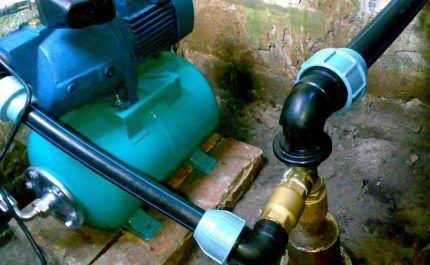
When installing a pumping station at the mouth of a deep well, a caisson is used so that the devices are as close as possible to the water source. Caisson - this is a container, quite spacious, in which holes and components are provided for convenient installation of pumping equipment.
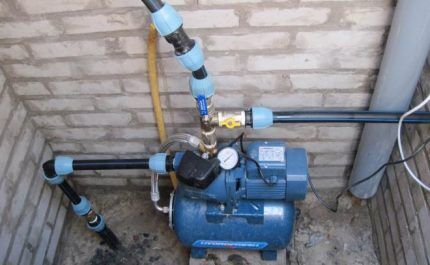
Finished products of this type are sold in specialized stores; you can choose an option that is suitable in size and configuration.They are made from plastic, metal, polymer-sand compositions. To independently arrange a caisson, the pit is deepened and widened, the walls are lined with bricks, and a durable cover is mounted on top.
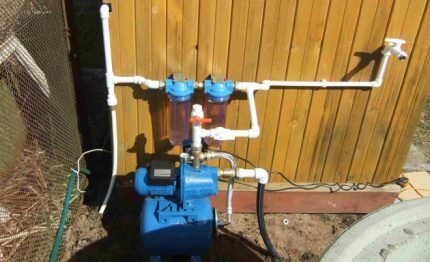
Often, instead of brickwork of caisson nets, concrete rings are used, between which the joints are sealed, and then waterproofing work is carried out. Pumping equipment is installed in the resulting small room.
The installation depth should protect equipment buried in the ground from freezing even in the most severe cold weather. In the southern regions, one and a half to two meters will be enough; in the north, a deepening of four meters may be necessary.
Connection procedure: step-by-step instructions
Pumping stations are suitable for equipping relatively deep water intake workings. If the depth of the groundwater table exceeds the maximum value specified by the equipment manufacturer, use remote ejectors.
To install, perform the following steps:
- A trench is laid connecting the well and housing.
- Pipes are laid in it.
- Install a water supply system (if it is missing).
- Install the unit in the selected location.
- The supply pipe is equipped with a filter and a check valve.
- Connect the line to the receiving pipe.
- Connect the unit to the water supply.
- Connect the equipment to the power supply.
- Fill the hydraulic tank with water.
- Perform a test run of the station.
- Check the joints.
- Set up the pressure switch.
External pipeline pipes water supply systems must be laid below the level to which the soil freezes.It is recommended to make a slight slope from the house to the well so that the water returns to the pump if it stops working. This will protect the device from overheating and damage due to dry running, i.e. work in the absence of water.
Performs the same protective function check valve, preventing liquid from leaving the pipe and going into the well. When connecting a surface pump equipped with an ejector, it is necessary to connect another one to the suction pipe, which is connected to the ejector.
This unit directs part of the incoming liquid to the base of the pipe through which the liquid flows, which significantly increases the productivity of the equipment. If used submersible pump, the work is done differently. It is connected to the suction pipe and suspended on a durable stainless steel cable.
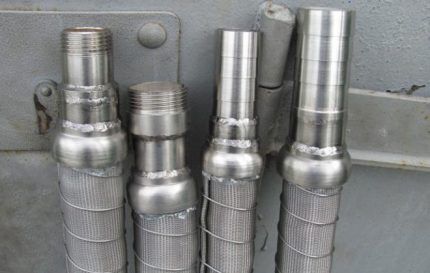
Submersible pumps are conveniently attached to a finished head. Such a device is mounted on the top of the casing pipe. It is believed that sealing a well with a cap allows it to slightly increase its flow rate. To prevent the cable and cable from getting tangled, they are fixed to the pipe using plastic ties.
If the filter is already in the pump, you are limited to installing a check valve. The edge of the surface pump supply line should be located at a height of more than a meter. This minimum distance is half a meter for a submersible pump.
Connections between the unit and pipes must be made using American taps; valves are used to shut off any section and disconnect it for repairs without damaging the remaining elements of the system.
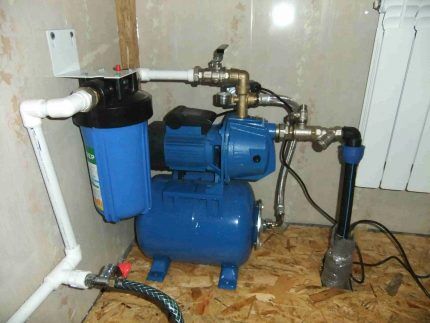
Installed in the workings well filter Over time, it wears out and sand begins to seep through it. It is recommended to install an additional coarse filter at the pump inlet.
Power supply is provided by connecting a separate line to the equipment, equipped with an automatic shutdown device; care must be taken to ground it. Before starting, the device is filled with water through the hole provided for this purpose.
There should be pressure in the hydraulic tank:
- about 1.5 bar for containers less than 30 l;
- about 1.8 bar for 30-50 l;
- 2 bar or a little less for a 50-100 l tank.
Then the hole for filling the water is closed and the device is connected to the electrical network. You need to open the valve slightly to bleed the air. In a few minutes, water will flow from here. Otherwise, turn off the device and add a little more liquid.
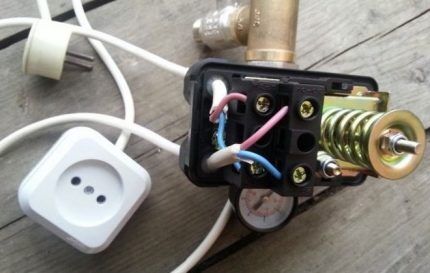
Turn on again so that the device starts working normally. Now you need configure the relay. To do this, the HA will have to be emptied and then filled again. Indicators are set by rotating the corresponding screws.
Some valuable recommendations
Threaded connections must be tightened with a wrench and not by hand to ensure the required tightness. For connecting fittings, protective devices and the pumping station it is better to use pipes whose diameter is slightly larger than the calculated one in order to compensate for the load increased due to bends in the line.
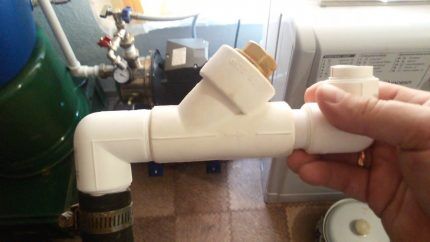
To protect the pump from idling, you can install a recirculation line. To do this, tees are placed on the supply and suction pipes and the free pipes are connected with a return line.
A valve should be placed on it to control the intensity of the reverse flow. This addition will improve the pressure, but will slightly reduce the performance of the device.
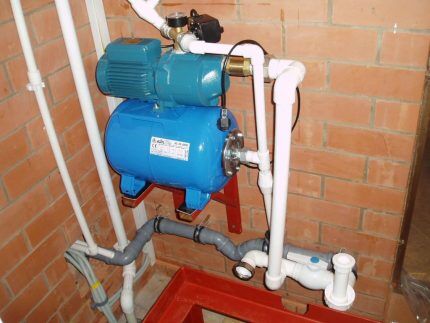
The pumping station is placed on a perfectly level base equipped with shock-absorbing pads. This will reduce the vibration impact and also reduce the amount of noise.
About once every three months you need to check:
- condition of joints for leaks.
- condition of filters for timely cleaning.
- relay settings for their correction;
- the condition of the hydraulic tank to determine the location of leaks.
If the pressure level in the HA does not meet the required level, it is easy to pump it up using a compressor or pump. On larger containers a nipple connection is provided for this purpose. If fluid leaks from the hole, the inner membrane is torn and needs to be replaced.
Conclusions and useful video on the topic
Video #1. Performing piping of pumping equipment:
Video #2. Detailed overview of installation in a caisson:
Video #3. Connecting the unit to the needle well:
Once you understand the structure and operating principles of surface pumping equipment, you can handle the installation without any problems. You need to choose high-quality equipment, follow the rules of its operation, and perform timely maintenance. Compliance with these conditions will ensure correct operation of the unit and uninterrupted water supply.
Please write comments in the block form located under the text of the article. Tell us about how you installed and connected pumping equipment for automatic pumping of water. Share technological subtleties that are useful to them with site visitors.



